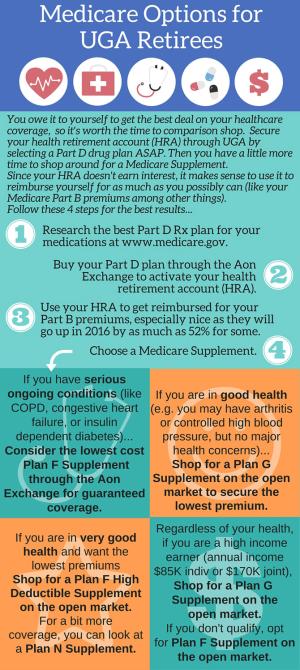The Grumpy Retiree on Health Insurance: Great Help and Useful Discoveries
Comment
In doing my research into the details of our new and improved health benefit, I’ve come across a great many things. One thing I’ve discovered is that there are lots of people working for UGA, the University System of Georgia and even Aon Hewitt who are trying hard to help us, the USG retirees, get the most out of what the regents have come to define as our health benefit in retirement. UGA has gone out of its way to create our Retiree Resource Center, staffing it with volunteers and staff whose only job is to help us make our health benefit choices as wisely as possible. While they can’t tell us exactly what we should do, they do what they can to help us see what our options are.
USG has dedicated one of its staff benefits people, Lydia Lanier, to work at the center every day. She moved to USG after a long career at UGA where she came to be in charge of their staff benefits office. She really has a passion to want this to work as well as possible for us, having seen what poorly considered individual decisions can do to hurt lives in the face of unexpected tragedies.
Aon Hewitt has committed one of its more senior people working in the state, David Rew, to help coordinate the messages getting to those of us who have dropped in on the center. He really wants us to have the best picture of what is possible, so that we, when we start talking on the phone with our AH “counselors” and reading more of the details about the insurance plans online, can better make sense of things.
The scores of us who are stopping by the center every day—many confused, frustrated and even somewhat angry—are encountering people who are there to make this process more understandable. They spend their days trying to help us be better prepared to deal with what most of us thought we would never need to dig into in great detail. Even while I confess to having really resented the need to get into something that is, honestly, very complicated, I have learned a couple of things about our options that might actually be helpful.

Photo Credit: Courtesy of Hardin Insurance
If you can live with networked physicians and hospitals that work like big HMOs, the Medicare Advantage plans don’t have to come with big monthly premiums. Of course, they are directly subsidized by Medicare with a little help from our premiums. Some of those plans even build in coverage for prescription drugs. But, their deductibles, copays and potential out-of-network costs leave me unsure of just what getting sick might really cost. They do come with caps on the most you might pay, though something like up to $6,700 per individual per year can look like a lot to some of us.
Should your doctors not be in those networks (and mine aren’t), that pushes you to be interested in Medigap plans, along with a Medicare Part D for prescription drug coverage. There may be a number of different plans offered by an insurer, but by law, one Plan F has to be identical in coverage to any other Plan F. While the most popular Medigap plans (Plan F) are the most comprehensive when it comes to hospital and doctor bills, the slightly less costly plans (especially Plan G) may make more sense. Insurers are free to set their own premiums, and they do differ considerably, but why pay more than you need to?
Prescription drug coverage through Medicare Part D does get pretty simple, once you put the list of drugs you regularly take into the AH website. Just choose the plan that gives you the lowest total annual cost. The AH website will even sort them to make it easier. Now, if you need new or different drugs, all bets are off, but that makes the annual open enrollment period at the end of every year a welcome backup.
If there was one single thing I could get the word out about before too many of us get too far along and, perhaps, make ill-considered decisions, it would be about the flexibility that is there in what we can do with our health benefit accounts (the $2,763 per individual next year). To remain eligible for USG benefit contributions after 2016, the single requirement is that you purchase at least one plan from among the Medicare Advantage, Medigap or Medicare Part D plans. Money in your health benefit account can be used to reimburse you for premiums of plans purchased through the AH exchange, for out-of-pocket prescription drug costs—no, Medicare Part D plans do not generally cover 100 percent—hospital and doctor copays and even your monthly Medicare premium that most of us have withheld from our Social Security checks.
My own array of expected out-of-pocket costs would easily chew up my $2,763. So, what I’m planning to do is just buy my lowest total cost Medicare Part D drug plan (for about $20 per month) and use the rest of my benefit to pay for all those other things. I’m going to actually buy Medigap coverage on my own outside our “private marketplace”—not because it’s going to be much less than those in our “marketplace” (though it’s a heck of a lot less than BC/BS!) but because I get to simply make my own selection from the much bigger open and public market. May as well put some of my fact-finding about this stuff to use. You will, of course, have to do your own math to see if you’ll be better off with a different configuration of plans.
So, lots of things to consider. Your decisions aren’t likely to be just like mine. But we do have lots of support from some good, caring people along the way. USG may have walked away from the promises we all heard them make about health benefits in our retirement, but we do have some help to stay afloat!










comments